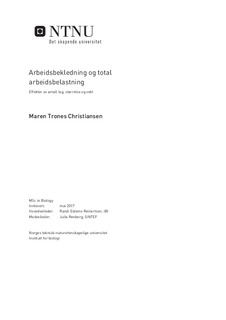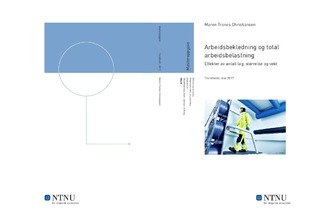| dc.description.abstract | Background: Work clothing with multiple layers and personal protective equipment is used in demanding environments. It s shown that clothing details such as number of layers, fit and weight can affect the total workload. Results from clothing studies carried out in the 1970s still form the basis for today s recommendations regarding use of work clothing (Lotens, 1988, Rintamäki, 2005). Multiple layers make it possible to regulate heat exchange in the clothing when there s variation in work intensity and ambient temperature, but previous studies have measured an additional energy cost of 3-4% for each layer (Teitlebaum and Goldman, 1972, Amor et al., 1973). Today s work clothing is made of new material, has lower weight and the ability to adjust fit. It s therefor of interest to investigate if the recommendations and guidelines that are based on the workload as it was in the 1970s still applies.
Aim: The aim of the study was to investigate how the number of layers, one size larger outerwear and weight in modern work wear affect the total workload.
Method: A controlled laboratory study was conducted, where five clothing concepts were tested on 20 subjects to investigate whether they affected workload. Work was simulated with 5 minutes walking on a treadmill at 5 km⋅h-1, at 0° and 6° rise. The clothing concepts were examined at controlled ambient temperatures, and the subjects became thermally neutral during rest periods before the next concept where tested. Workload was measured as oxygen consumption (VO2), heart rate (HR), metabolic rate (MR) and degree of exertion.
Results: An additional clothing layer increased VO2 by 1,8% when walking at 6° rise, and had no effect at 0° rise. One larger size in outerwear had no effect on workload. Multi-layer work clothing and personal protective equipment affected workload and degree of exertion. Work clothing and personal protective equipment increased VO2 by 17,9% and 15,8% compared to a single layer at 0° and 6° rise.
Conclusion: Workload is affected by clothing and work intensity. Use of an additional layer had only an effect at higher intensity. Multiple layers make regulation of heat exchange easier in the clothing, which overcomes the disadvantage of a low increase in energy cost. One size larger outerwear had no effect on workload during walking, which may be due to good tightening mechanisms that provide better fit. Total weight is greatest when wearing work wear and personal protective equipment, which reflects a real workload. It s the increase in weight that affects the workload to the greatest extent. | nb_NO |

